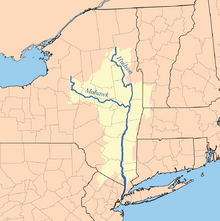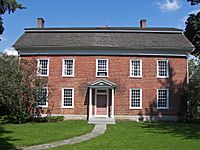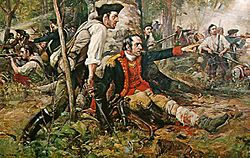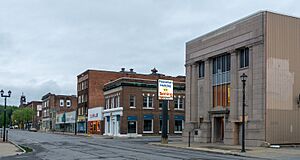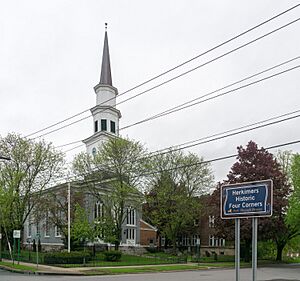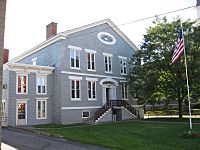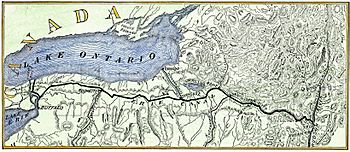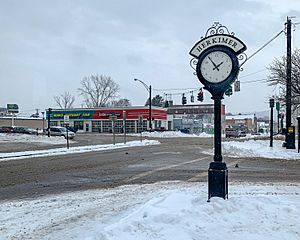Herkimer (village), New York facts for kids
Quick facts for kids
Herkimer, New York
|
|
|---|---|
|
Village
|
|
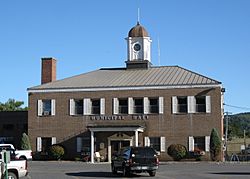
Herkimer Municipal Hall, September 2009
|
|

Location within Herkimer County
|
|
| Country | United States |
| State | New York |
| County | Herkimer |
| Town | Herkimer |
| Area | |
| • Total | 2.70 sq mi (7.00 km2) |
| • Land | 2.59 sq mi (6.70 km2) |
| • Water | 0.12 sq mi (0.30 km2) |
| Elevation | 384 ft (117 m) |
| Population
(2020)
|
|
| • Total | 7,234 |
| • Density | 2,795.21/sq mi (1,079.07/km2) |
| Time zone | UTC-5 (Eastern (EST)) |
| • Summer (DST) | UTC-4 (EDT) |
| ZIP code |
13350
|
| Area code(s) | 315 |
| FIPS code | 36-34121 |
| GNIS feature ID | 0952621 |
Herkimer is a small village located in New York, United States. It sits on the north side of the Mohawk River. Herkimer is also the main town, or county seat, of Herkimer County. It is about 15 miles (24 km) southeast of Utica.
In 2020, about 7,234 people lived in Herkimer. The village is named after the Herkimer family. They were German immigrants who settled here in 1723. A famous family member was Nicholas Herkimer. He was a general during the American Revolutionary War. He was hurt in the Battle of Oriskany and later died from his injuries.
The village of Herkimer is part of the larger town of Herkimer and Herkimer County. People often call them "the Herkimers." This means that people living in the village are served by three levels of government with the same name: the village, the town, and the county. Herkimer County Community College is also located in the northwest part of the village. It was started in 1966.
Contents
History of Herkimer
Early Settlements and Native Americans
For many centuries, the Iroquois Mohawk Native American people lived in this area. Their villages were connected by paths along the Mohawk River. By the early 1700s, they had two main villages in the Mohawk River Valley.
German families, called Palatines, first came to New York in 1708. Many more arrived in 1710. They were refugees from religious wars in Europe. They agreed to work in exchange for their journey to the New York Colony. In 1710, about 2,800 Germans arrived in 10 ships. They first stayed on Nutten Island (now Governors Island). Later, some moved upriver to settle along Schoharie Creek.
The Burnetsfield Patent
In 1722, German leaders asked Governor William Burnet for land. He allowed them to buy land from the Mohawk Nation. This land was near where West Canada Creek meets the Mohawk River. Many more settlers arrived between 1723 and 1725. They settled on both sides of the Mohawk River.
The area was first called "Burnetsfield" after the governor. The Burnetsfield Patent was granted on April 13, 1725. It gave 100-acre lots to about 90 families. The area was also known as "German Flatts" because most settlers were German. This was the first European settlement so far west in the Mohawk Valley.
Soon after 1722, a strong building called a blockhouse and a church were built. This church later became the Reformed Church. A schoolhouse was built in 1745.
French and Indian War Attacks
During the French and Indian War, the town was attacked twice. French forces and their Native American allies attacked in November 1757. They attacked again in April 1758. About 30 settlers were killed. Captain Nicholas Herkimer was in charge of the fort. He gathered all the settlers inside it for safety.
American Revolutionary War and Fort Dayton
During the Revolutionary War, the town was attacked many times. These attacks were by Loyalists (people loyal to Britain) and their Iroquois allies. One attack was by Butler's Rangers in September 1778. The village was defended by Fort Dayton.
Fort Herkimer and the settlement on the south side of the river were also attacked. In 1779, three children, George, Catherine, and Nicholas Demuth, were captured. They were playing outside the fort when the Onondaga captured them. After the war, George and Catherine returned to their family. Nicholas, the youngest, had been adopted by an Onondaga chief. He chose to stay with the tribe for the rest of his life. He kept in touch with his birth family but lived with the Onondaga. He married into the tribe and worked as an interpreter.
The village of Herkimer was attacked one last time on July 15, 1782. About 500 Loyalists and Iroquois attacked. Two residents were killed. The others reached the safety of the fort. Many horses and cattle were taken or killed. Several houses and barns were burned.
Growth of Herkimer Village
In 1788, the area was officially organized as the township of Herkimer. The town became known as the "Village of Herkimer." In 1791, when Herkimer County was formed, the village of Herkimer became the county seat. By 1797, the village had a courthouse, a jail, and a church. It had about 40 houses and 250 people. The village officially became a village in 1807.
In the early 1800s, Herkimer had several whiskey distilleries. It also had a place to make potash, which was used for soap. By the mid-1800s, the village was served by the New York Central & Hudson River Railroad. This railroad went north through the Adirondacks. An electric trolley also connected Herkimer to other nearby villages.
The Erie Canal was built from 1817 to 1825. It also helped the villages and towns in the valley. The canal carried more goods and people between the Great Lakes and the Hudson River. This helped trade with the port of New York.
Francis E. Spinner, who was from Herkimer, was the treasurer of the United States during the time of President Lincoln. There is a statue of him in Myers Park.
By the late 1800s, the village had a public library. The Folts Mission Institute opened in 1893. It was a training school for young women. In 1907, a monument was built to honor General Herkimer.
Several historic buildings in Herkimer are listed on the National Register of Historic Places. These include the Herkimer County Courthouse, the Herkimer County Jail, and The Reformed Church. In 2000, the United States Congress named the historic route of the Erie Canal as the Erie Canalway National Heritage Corridor. This means the villages, towns, and landscape along the canal are important.
Geography of Herkimer
The village of Herkimer is in central New York state. It is about halfway between Syracuse and Albany. It is also about 15 miles (24 km) southeast of Utica. You can reach it from exit 30 on the New York State Thruway (Interstate 90).
Herkimer is located where the Mohawk River meets West Canada Creek. There is a large wildlife area called Plantation Island State Wildlife Management Area. It is about 300 acres (1.2 km²) of Mohawk River floodplain. A smaller wildlife area is northeast of the village. It provides access for fishing on the creek.
Herkimer Diamonds
The Herkimer area is famous for its unique quartz crystals. These are known as "Herkimer diamonds." They are not real diamonds, but they look like them. They are clear and shiny, like diamonds. People who enjoy collecting rocks love this area.
These crystals formed in ancient limestone and dolomite rock. This rock was made from an old sea. Many people believe it's good luck to find a crystal still partly stuck in its host rock.
There are several places where tourists can dig for these "diamonds." You can break up rock or sift through soil to find the quartz. The quartz itself is very strong and does not wear away easily.
Population and People
| Historical population | |||
|---|---|---|---|
| Census | Pop. | %± | |
| 1870 | 1,220 | — | |
| 1880 | 2,359 | 93.4% | |
| 1900 | 5,555 | — | |
| 1910 | 7,420 | 33.6% | |
| 1920 | 10,453 | 40.9% | |
| 1930 | 10,446 | −0.1% | |
| 1940 | 9,617 | −7.9% | |
| 1950 | 9,400 | −2.3% | |
| 1960 | 9,396 | 0.0% | |
| 1970 | 8,960 | −4.6% | |
| 1980 | 8,383 | −6.4% | |
| 1990 | 7,945 | −5.2% | |
| 2000 | 7,498 | −5.6% | |
| 2010 | 7,743 | 3.3% | |
| 2020 | 7,234 | −6.6% | |
| U.S. Decennial Census 2020 | |||
In 2000, there were 7,498 people living in Herkimer. There were 3,184 households. About 23.6% of households had children under 18. The average household had 2.21 people. About 22.6% of the population was 65 years or older.
Major Highways
Media and News
Herkimer has one daily newspaper, the Times Telegram. It is published in nearby Utica. Herkimer is also part of the Utica media market. Three radio stations are licensed to Herkimer: WNRS (1420 AM), WXUR (92.7 FM), and WVHC (91.5 FM). WVHC is licensed to Herkimer County Community College.
Education in Herkimer
The village is part of the Herkimer Central School District.
Herkimer County Community College is a two-year college. It is located in the northwestern part of the village.
Sports in Herkimer
The Herkimer Originals are a basketball team. They are owned by Scott Flansburg. They have played in the American Basketball Association since 2021. They use local places like Herkimer County Community College for their games.
Notable People from Herkimer
- George Cogar (1932–1983), a computer pioneer and businessman.
- Scott Flansburg (born 1963), known for his amazing speed in mental math.
- Jonas Folts (1808–1876), a farmer and politician in Wisconsin.
- Nicholas Herkimer (c. 1728–1777), a general during the American Revolutionary War.
- Charles S. Millington (1855–1913), a U.S. congressman.
- Donald J. Mitchell (1923–2003), a U.S. congressman.
- H.M. Quackenbush (1847–1933), an inventor and industrialist.
- Francis E. Spinner (1802–1890), the treasurer of the United States during the Lincoln administration.
- Abram B. Steele (1845–1913), a lawyer and member of the New York State Assembly.
- Horace H. Witherstine (1852–1924), a doctor and politician.
See also
 In Spanish: Herkimer (villa) para niños
In Spanish: Herkimer (villa) para niños




